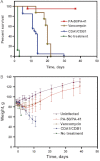Protection against Clostridium difficile infection with broadly neutralizing antitoxin monoclonal antibodies
- PMID: 22732923
- PMCID: PMC3491748
- DOI: 10.1093/infdis/jis416
Protection against Clostridium difficile infection with broadly neutralizing antitoxin monoclonal antibodies
Abstract
The spore-forming bacterium Clostridium difficile represents the principal cause of hospital-acquired diarrhea and pseudomembranous colitis worldwide. C. difficile infection (CDI) is mediated by 2 bacterial toxins, A and B; neutralizing these toxins with monoclonal antibodies (mAbs) provides a potential nonantibiotic strategy for combating the rising prevalence, severity, and recurrence of CDI. Novel antitoxin mAbs were generated in mice and were humanized. The humanized antitoxin A mAb PA-50 and antitoxin B mAb PA-41 have picomolar potencies in vitro and bind to novel regions of the respective toxins. In a hamster model for CDI, 95% of animals treated with a combination of humanized PA-50 and PA-41 showed long-term survival relative to 0% survival of animals treated with standard antibiotics or comparator mAbs. These humanized mAbs provide insight into C. difficile intoxication and hold promise as potential nonantibiotic agents for improving clinical management of CDI.
Figures



Similar articles
-
A chimeric toxin vaccine protects against primary and recurrent Clostridium difficile infection.Infect Immun. 2012 Aug;80(8):2678-88. doi: 10.1128/IAI.00215-12. Epub 2012 May 21. Infect Immun. 2012. PMID: 22615245 Free PMC article.
-
Novel Clostridium difficile Anti-Toxin (TcdA and TcdB) Humanized Monoclonal Antibodies Demonstrate In Vitro Neutralization across a Broad Spectrum of Clinical Strains and In Vivo Potency in a Hamster Spore Challenge Model.PLoS One. 2016 Jun 23;11(6):e0157970. doi: 10.1371/journal.pone.0157970. eCollection 2016. PLoS One. 2016. PMID: 27336843 Free PMC article.
-
A Combination of Three Fully Human Toxin A- and Toxin B-Specific Monoclonal Antibodies Protects against Challenge with Highly Virulent Epidemic Strains of Clostridium difficile in the Hamster Model.Clin Vaccine Immunol. 2015 Jul;22(7):711-25. doi: 10.1128/CVI.00763-14. Epub 2015 Apr 29. Clin Vaccine Immunol. 2015. PMID: 25924765 Free PMC article.
-
Actoxumab + bezlotoxumab combination: what promise for Clostridium difficile treatment?Expert Opin Biol Ther. 2018 Apr;18(4):469-476. doi: 10.1080/14712598.2018.1452908. Epub 2018 Mar 15. Expert Opin Biol Ther. 2018. PMID: 29534621 Review.
-
Bezlotoxumab: First Global Approval.Drugs. 2016 Dec;76(18):1793-1798. doi: 10.1007/s40265-016-0673-1. Drugs. 2016. PMID: 27905086 Review.
Cited by
-
Broad coverage of genetically diverse strains of Clostridium difficile by actoxumab and bezlotoxumab predicted by in vitro neutralization and epitope modeling.Antimicrob Agents Chemother. 2015 Feb;59(2):1052-60. doi: 10.1128/AAC.04433-14. Epub 2014 Dec 1. Antimicrob Agents Chemother. 2015. PMID: 25451052 Free PMC article. Clinical Trial.
-
Use of a neutralizing antibody helps identify structural features critical for binding of Clostridium difficile toxin TcdA to the host cell surface.J Biol Chem. 2017 Sep 1;292(35):14401-14412. doi: 10.1074/jbc.M117.781112. Epub 2017 Jul 13. J Biol Chem. 2017. PMID: 28705932 Free PMC article.
-
A mixture of functionally oligoclonal humanized monoclonal antibodies that neutralize Clostridium difficile TcdA and TcdB with high levels of in vitro potency shows in vivo protection in a hamster infection model.Clin Vaccine Immunol. 2013 Mar;20(3):377-90. doi: 10.1128/CVI.00625-12. Epub 2013 Jan 16. Clin Vaccine Immunol. 2013. PMID: 23324518 Free PMC article.
-
Recent advances in the treatment of C. difficile using biotherapeutic agents.Infect Drug Resist. 2019 Jun 10;12:1597-1615. doi: 10.2147/IDR.S207572. eCollection 2019. Infect Drug Resist. 2019. PMID: 31354309 Free PMC article.
-
Variations in virulence and molecular biology among emerging strains of Clostridium difficile.Microbiol Mol Biol Rev. 2013 Dec;77(4):567-81. doi: 10.1128/MMBR.00017-13. Microbiol Mol Biol Rev. 2013. PMID: 24296572 Free PMC article. Review.
References
-
- Rupnik M, Wilcox MH, Gerding DN. Clostridium difficile infection: new developments in epidemiology and pathogenesis. Nat Rev Microbiol. 2009;7:526–36. - PubMed
-
- McDonald LC, Killgore GE, Thompson A, et al. An epidemic, toxin gene-variant strain of Clostridium difficile. N Engl J Med. 2005;353:2433–41. - PubMed
-
- Cohen SH, Gerding DN, Johnson S, et al. Clinical practice guidelines for Clostridium difficile infection in adults: 2010 update by the Society for Healthcare Epidemiology of America (SHEA) and the Infectious Diseases Society of America (IDSA) Infect Control Hosp Epidemiol. 2010;31:431–55. - PubMed
-
- Ghantoji SS, Sail K, Lairson DR, DuPont HL, Garey KW. Economic healthcare costs of Clostridium difficile infection: a systematic review. J Hosp Infect. 2010;74:309–18. - PubMed
Publication types
MeSH terms
Substances
Grants and funding
LinkOut - more resources
Full Text Sources
Other Literature Sources
Medical
Molecular Biology Databases

